ELF-MF Exposure, Actual and Perceived, and Associated Health Symptoms: A Case Study of an Office Building in Tel Aviv-Yafo, Israel
Abstract
:1. Introduction
2. Methods
2.1. ELF-MF Measurements
2.2. Questionnaires
2.3. Statistical Analysis
3. Results
3.1. ELF-MF Measurements and Their Associations with Perceived Exposure
3.2. Regression Analysis
4. Discussion
5. Conclusions
- The analysis revealed no significant association between instrumentally measured and perceived ELF-MF exposure, which implies that individuals cannot detect actual ELF-MF exposure accurately;
- The analysis revealed that feelings of weakness, headache, frustration and worries were associated with both measured and perceived ELF-MF exposure, while perceived ELF-MF exposure was also found to be associated with eye pain and irritation, sleepiness, as well as dizziness and ear pain.
- As we conclude, working near a high voltage power line appears to produce not only psychological but also physiological effects, and should thus become a public health concern.
Author Contributions
Funding
Institutional Review Board Statement
Informed Consent Statement
Data Availability Statement
Conflicts of Interest
Appendix A
- A.
- Aaronia NF-5035 Spectrum Analyzer

- -
- Frequency range: 1 Hz–1 MHz;
- -
- 3D magnetic-field measurement coil;
- -
- Typical level range: 1 nT to 2 mT;
- -
- Filter bandwidth (min/max): 0.3 Hz (min)/10 MHz (max);
- -
- Typical precision base unit: 3%;
- -
- Range analog input (typical): 200 nV (min)–200 mV (max);
- -
- FFT (resolution in points): 1024;
- -
- Vector power measurement (I/Q) and true RMS: Yes;
- -
- Weight: 430 g;
- -
- Tripod connection: 1/4”.
- B.
- Tenmars TM-192D Field Meter

- -
- 30 Hz to 2000 Hz frequency range;
- -
- For triple-axis measurements of low-frequency electromagnetic fields;
- -
- Quick and easy measurement with three-channel measurement sensors;
- -
- Built-in USB communication for data-logging; capacity of 500 or 9999 datasets;
- -
- Magnetic field unit is Tesla (T) or Gauss (G);
- -
- Data hold (HOLD), maximum hold (MAX), and minimum hold (MIN) functions;
- -
- Auto range or manual range select mode;
- -
- Easy and safe to use;
- -
- Low-battery detector;
- -
- Overload indication;
- -
- Auto-power off function.
- -
- Display: 4-digit, triple liquid crystal display;
- -
- Measuring range: 20, 200, 2000 mG; 2, 20, 200 uT;
- -
- Resolution: 0.01, 0.1, 1 mG or 0.001, 0.01, 0.1 uT;
- -
- Frequency response: 30 Hz to 2000 Hz;
- -
- Sensor: triple-axis (X, Y, Z);
- -
- Accuracy (20 mG/2 uT): ± (3.0% + 30 dgt) at 50/60Hz; ± (2.5% + 5 dgt) at 50/60 Hz; ± (5.0% + 5 dgt) at 30/2000 Hz;
- -
- Sample rate: 2.5 times/s;
- -
- Overload (LCD): OL displayed;
- -
- Power supply: 9 volt battery, NEDA 1604, IEC 6F22, or JIS 006P;
- -
- Battery life: approx. 100 h.
Appendix B






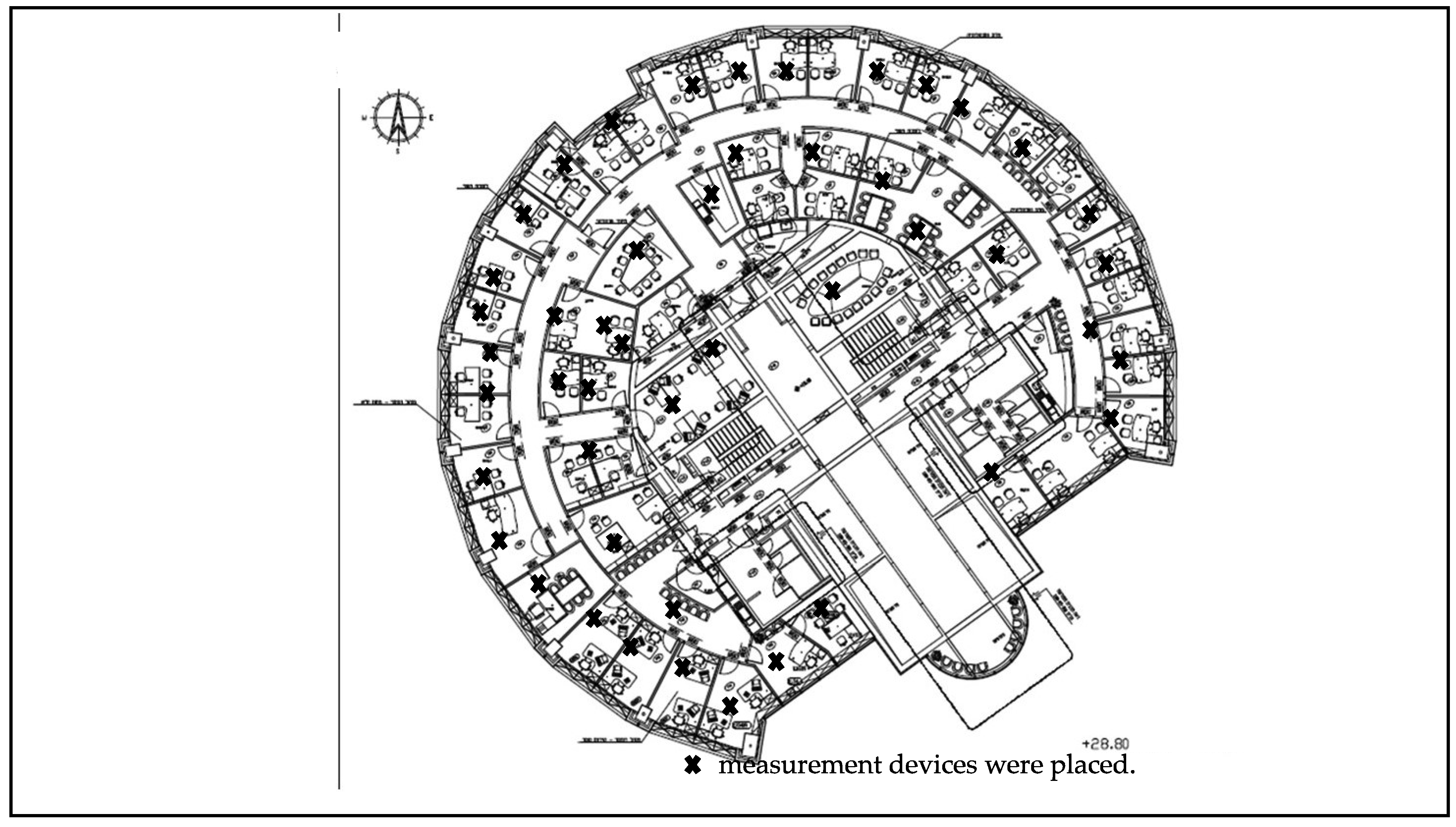






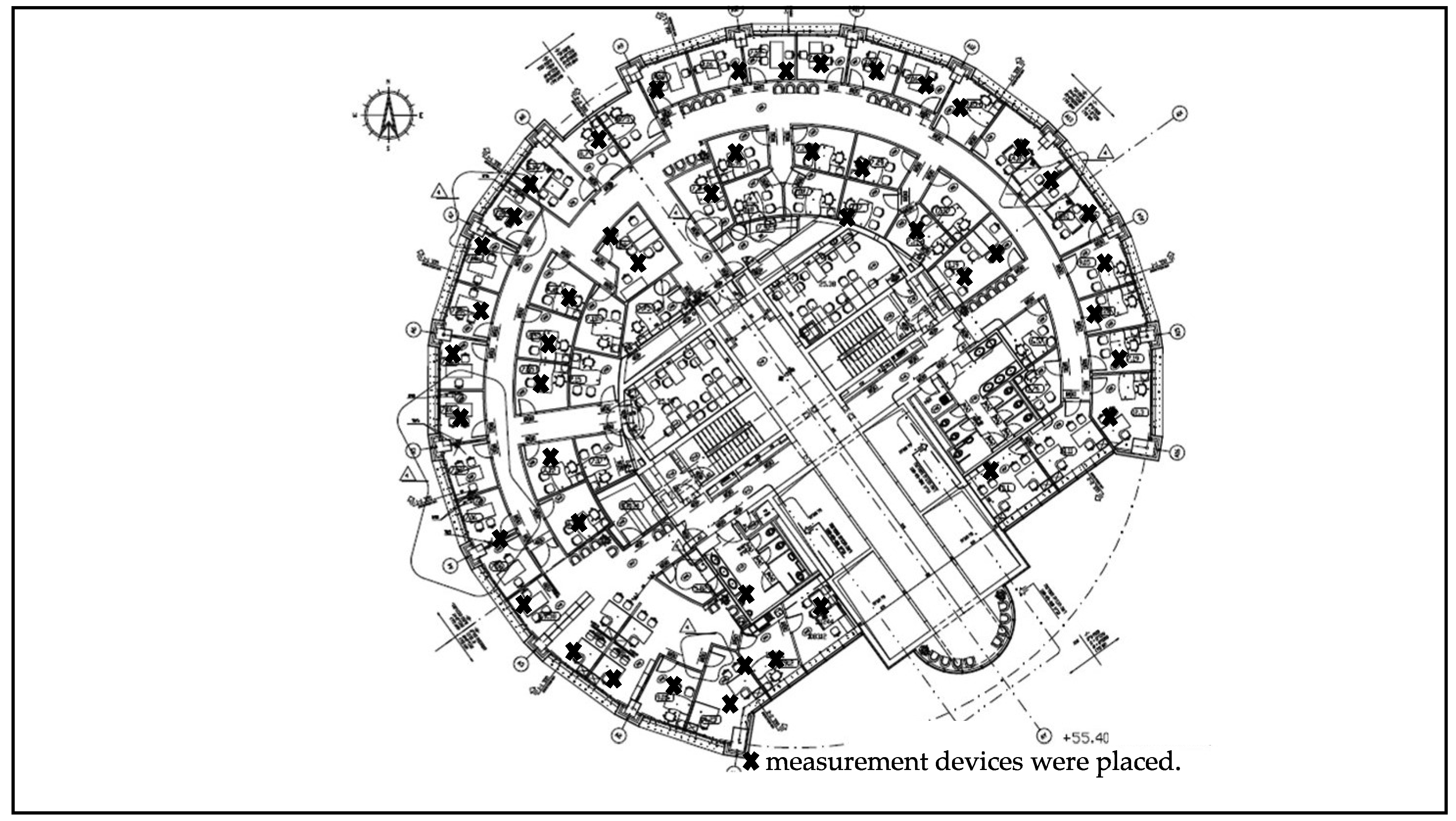
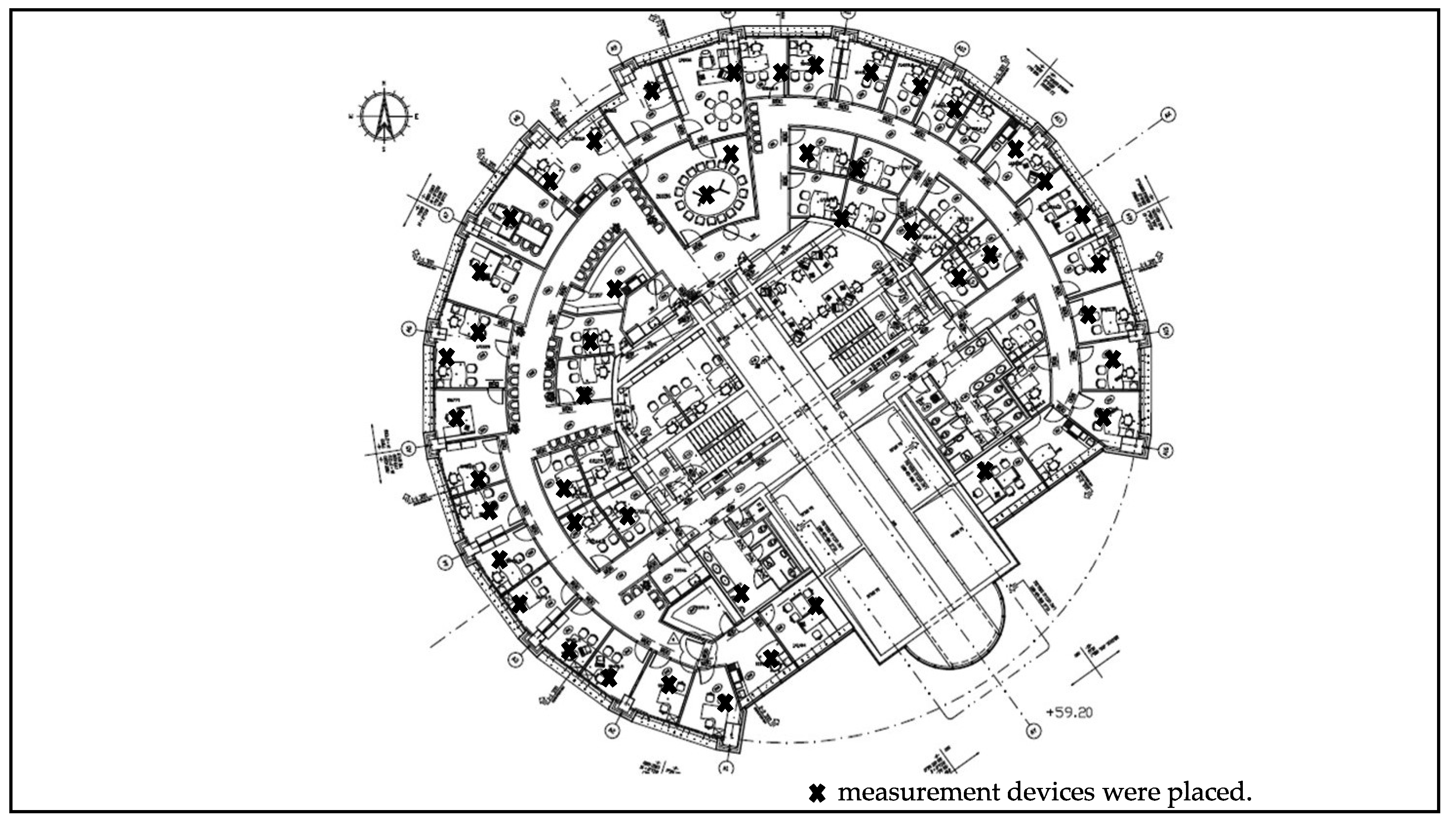
References
- Bridge, B.A.; Adhikari, D.; Fontenla, M. Electricity, income, and quality of life. Soc. Sci. J. 2016, 53, 33–39. [Google Scholar] [CrossRef]
- Petrie, K.J.; Sivertsen, B.; Hysing, M.; Broadbent, E.; Moss-Morris, R.; Eriksen, H.R.; Ursin, H. Thoroughly modern worries: The relationship of worries about modernity to reported symptoms, health and medical care utilization. J. Psychosom. Res. 2001, 51, 395–401. [Google Scholar] [CrossRef]
- Paniagua, J.M.; Jimenez, A.; Rufo, M.; Gutierrez, J.A.; Gomez, F.J.; Antolin, A. Exposure to extremely low frequency magnetic fields in an urban area. Radiat. Environ. Biophys. 2007, 46, 69–76. [Google Scholar] [CrossRef]
- Belyaev, I.; Dean, A.; Eger, H.; Hubmann, G.; Jandrisovits, R.; Kern, M.; Kundi, M.; Moshammer, H.; Lercher, P.; Müller, K.; et al. EUROPAEM EMF Guideline 2016 for the prevention, diagnosis and treatment of EMF-related health problems and illnesses. Rev. Environ. Health 2016, 31, 363–397. [Google Scholar] [CrossRef]
- Teepen, J.C.; van Dijck, J.A. Impact of high electromagnetic field levels on childhood leukemia incidence. Int. J. Cancer/J. Int. Du Cancer 2012, 131, 769–778. [Google Scholar] [CrossRef] [PubMed]
- International Agency for Research on Cancer (IARC). Non-Ionizing Radiation, Part 1: Static and Extremely Low-Frequency (ELF) Electric and Magnetic Fields; IARC Press: Lyon, France, 2002. [Google Scholar]
- Rubin, G.J.; Nieto-Hernandez, R.; Wessely, S. Idiopathic environmental intolerance attributed to electromagnetic fields (formerly ‘electromagnetic hypersensitivity’): An updated systematic review of provocation studies. Bioelectromagnetics 2010, 31, 1–11. [Google Scholar] [CrossRef] [PubMed]
- World Health Organization. Electromagnetic Hypersensitivity. 2005. Available online: https://www.who.int/peh-emf/publications/facts/fs296/en/ (accessed on 26 March 2018).
- Baliatsas, C.; Van Kamp, I.; Lebret, E.; Rubin, G.J. Idiopathic environmental intolerance attributed to electromagnetic fields (IEI-EMF): A systematic review of identifying criteria. BMC Public Health 2012, 12, 643. [Google Scholar] [CrossRef] [PubMed]
- Beale, I.L.; Pearce, N.E.; Conroy, D.M.; Henning, M.A.; Murrell, K.A. Psychological effects of chronic exposure to 50 Hz magnetic fields in humans living near extra-high-voltage transmission lines. Bioelectromagnetics 1997, 18, 584–594. [Google Scholar] [CrossRef]
- Porsius, J.T.; Claassen, L.; Smid, T.; Woudenberg, F.; Timmermans, D.R. Health responses to a new high-voltage power line route: Design of a quasi-experimental prospective field study in the Netherlands. BMC Public Health 2014, 14, 237. [Google Scholar] [CrossRef]
- Techera, U.D. Measuring and Managing Construction Worker Fatigue. Ph.D. Thesis, University of Colorado at Boulder, Boulder, CO, USA, 2017. [Google Scholar]
- Kato, Y.; Johansson, O. Reported functional impairments of electrohypersensitive Japanese: A questionnaire survey. Pathophysiology 2012, 19, 95–100. [Google Scholar] [CrossRef]
- World Health Organization. What are Electromagnetic Fields? 2017. Available online: http://www.who.int/peh-emf/about/WhatisEMF/en/index1.html (accessed on 8 June 2020).
- McMahan, S.; Meyer, J. Symptom prevalence and worry about high voltage transmission lines. Environ. Res. 1995, 70, 114–118. [Google Scholar] [CrossRef] [PubMed]
- Porsius, J.T.; Claassen, L.; Smid, T.; Woudenberg, F.; Petrie, K.J.; Timmermans, D.R. Symptom reporting after the introduction of a new high-voltage power line: A prospective field study. Environ. Res. 2015, 138, 112–117. [Google Scholar] [CrossRef]
- Ramirez-Vazquez, R.; Escobar, I.; Franco, T.; Arribas, E. Physical units to report intensity of electromagnetic wave. Environ. Res. 2022, 204, 112341. [Google Scholar] [CrossRef] [PubMed]
- Aaronia, A.G. EMC/EMI Spectrum Analyzer with E & H Sensor SPECTRAN NF-5030. 2017. Available online: http://www.aaronia.com/products/spectrum-analyzers/NF-5030-EMC-Spectrum-Analyzer/ (accessed on 12 July 2021).
- Gelberg, S. Extremely Low Frequency Magnetic Fields Non_Ionizing_Radiation_Procedures_and_Guidelines; Noise & Radiation Abatement Department, Israel Ministry of Environmental Protection: Jerusalem, Israel, 2012. Available online: https://www.gov.il/BlobFolder/policy/non_ionizing_radiation_procedures_and_guidelines/he/radiation_non_ionizing_heating_packaging_and_incubators_elf_insturcions.pdf (accessed on 29 March 2017).
- World Health Organization. WHO Quality of Life-BREF (WHOQOL-BREF); World Health Organization: Geneva, Switzerland, 1991. [Google Scholar]
- World Health Organization. WHOQOL-BREF: Introduction, Administration, Scoring and Generic Version of the Assessment, Field Trial Version ed; World Health Organization: Geneva, Switzerland, 1996. [Google Scholar]
- World Health Organization. WHOQOL User Manual; World Health Organization: Geneva, Switzerland, 1998. [Google Scholar]
- World Health Organization. WHO Workshop on Electrical Hypersensitivity; World Health Organization: Prague, Czech Republic, 2004. [Google Scholar]
- Bowling, A.; Bond, M.; Jenkinson, C.; Lamping, D.L. Short Form 36 (SF-36) Health Survey questionnaire: Which normative data should be used? Comparisons between the norms provided by the Omnibus Survey in Britain, the Health Survey for England and the Oxford Healthy Life Survey. J. Public Health Med. 1999, 21, 255–270. [Google Scholar] [CrossRef]
- Kaszuba-Zwoinska, J.; Gremba, J.; Galdzinska-Calik, B.; Wojcik-Piotrowicz, K.; Thor, P.J. Electromagnetic field induced biological effects in humans. Przegl. Lek. 2015, 72, 636–641. [Google Scholar] [PubMed]
- Dieudonne, M. Does electromagnetic hypersensitivity originate from nocebo responses? Indications from a qualitative study. Bioelectromagnetics 2016, 37, 14–24. [Google Scholar] [CrossRef] [PubMed]
- Baliatsas, C.; Bolte, J.; Yzermans, J.; Kelfkens, G.; Hooiveld, M.; Lebret, E.; van Kamp, I. Actual and perceived exposure to electromagnetic fields and non-specific physical symptoms: An epidemiological study based on self-reported data and electronic medical records. Int. J. Hyg. Environ. Health. 2015, 218, 331–344. [Google Scholar] [CrossRef] [PubMed]
- Baliatsas, C.; Van Kamp, I.; Bolte, J.; Schipper, M.; Yzermans, J.; Lebret, E. Non-specific physical symptoms and electromagnetic field exposure in the general population: Can we get more specific? A systematic review. Environ. Int. 2012, 41, 15–28. [Google Scholar] [CrossRef]
- Szemerszky, R.; Gubanyi, M.; Arvai, D.; Domotor, Z.; Koteles, F. Is There a Connection Between Electrosensitivity and Electrosensibility? A Replication Study. Int. J. Behav. Med. 2015, 22, 755–763. [Google Scholar] [CrossRef]
- Baliatsas, C.; van Kamp, I.; Hooiveld, M.; Yzermans, J.; Lebret, E. Comparing non-specific physical symptoms in environmentally sensitive patients: Prevalence, duration, functional status and illness behavior. J. Psychosom. Res. 2014, 76, 405–413. [Google Scholar] [CrossRef] [Green Version]
- Nordin, S.; Neely, G.; Olsson, D.; Sandstrom, M. Odor and noise intolerance in persons with self-reported electromagnetic hypersensitivity. Int. J. Environ. Res. Public Health 2014, 11, 8794–8805. [Google Scholar] [CrossRef] [PubMed]
- Jia, P.; Lakerveld, J.; Wu, J.; Stein, A.; Root, E.D.; Sabel, C.E.; Vermeulen, R.; Remais, J.V.; Chen, X.; Brownson, R.C.; et al. Top 10 Research Priorities in Spatial Lifecourse Epidemiology. Environ. Health Perspect. 2019, 127, 74501. [Google Scholar] [CrossRef] [PubMed] [Green Version]
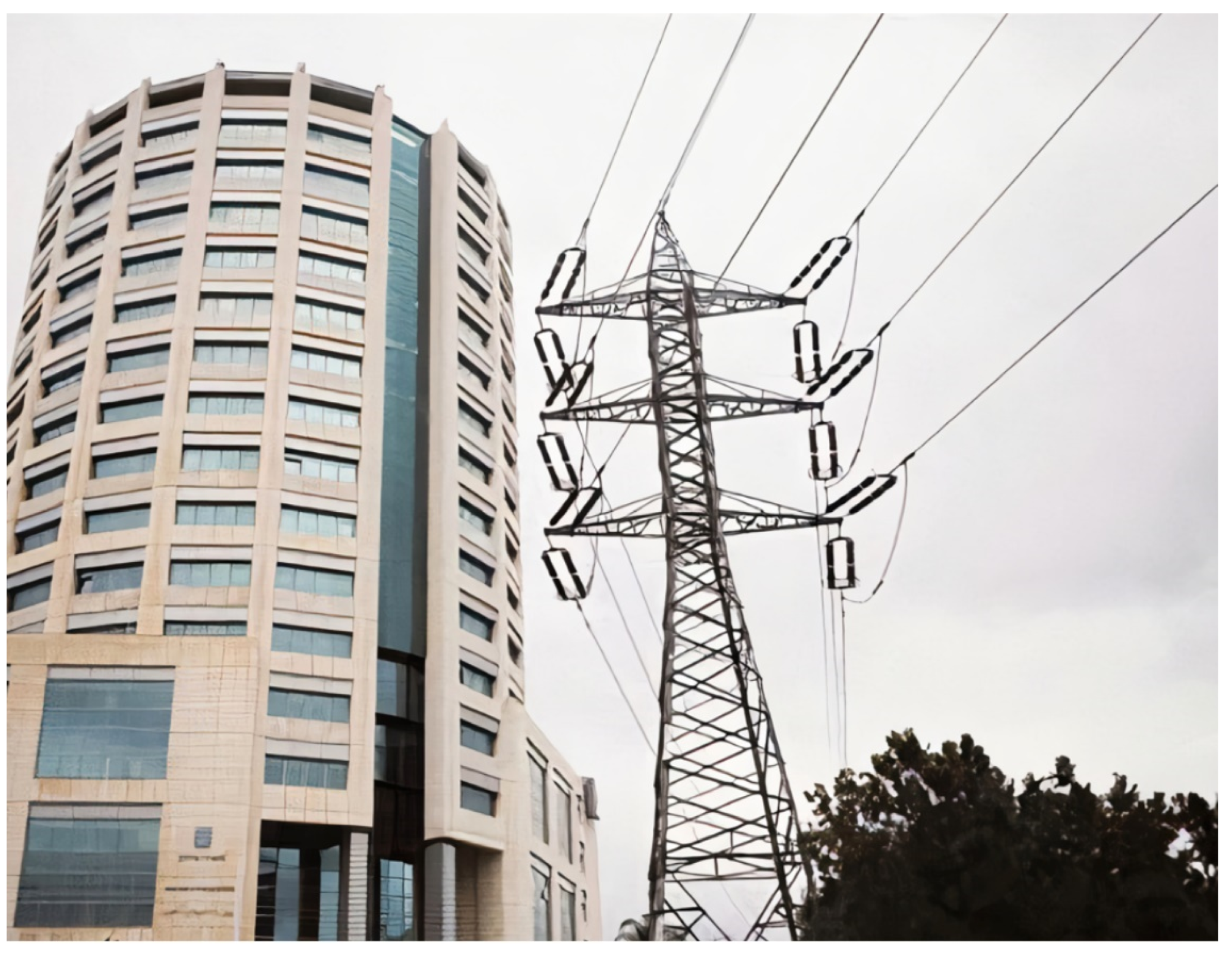
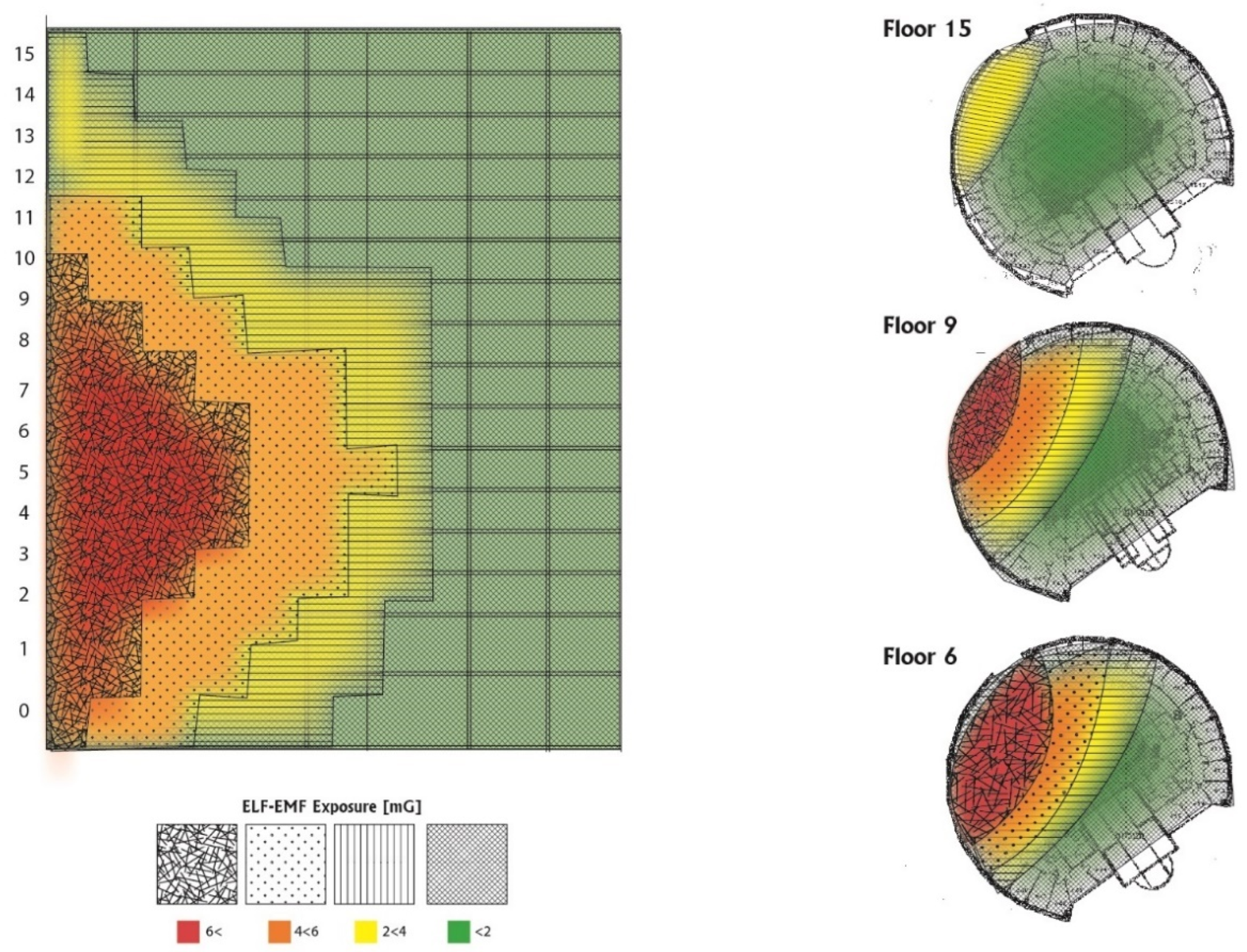
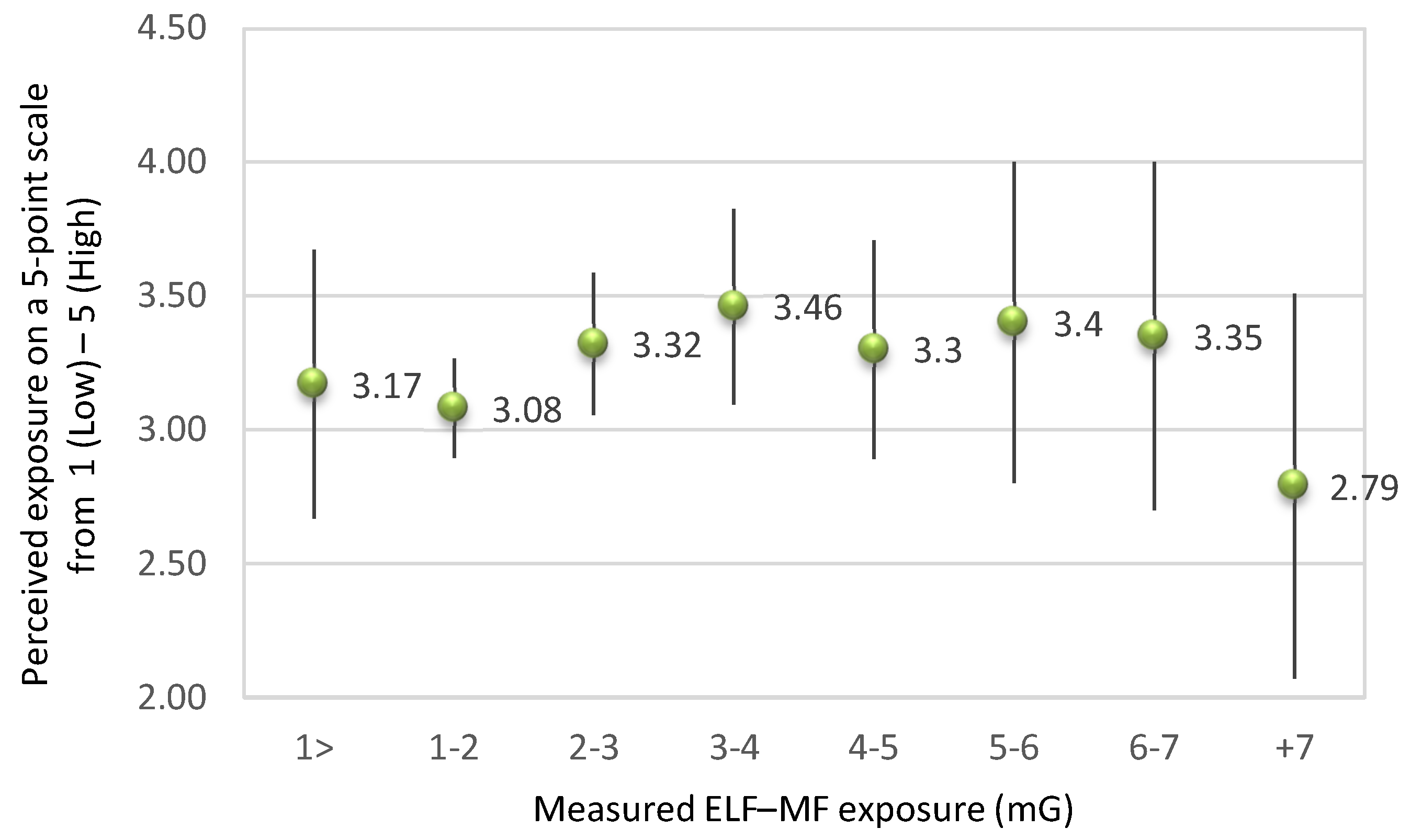

| Floor | Min | Max | Mean | SD | N |
|---|---|---|---|---|---|
| 1 | 0 | 1 | 0.43 | 0.51 | 14 |
| 2 | 0 | 2 | 0.45 | 0.63 | 29 |
| 3 | 0 | 5 | 1.39 | 1.55 | 36 |
| 4 | 0 | 6 | 2.25 | 1.76 | 28 |
| 5 | 0 | 6 | 2.44 | 1.8 | 39 |
| 6 | 0 | 5 | 2.77 | 1.54 | 43 |
| 7 | 0 | 5 | 2.65 | 1.93 | 43 |
| 8 | 0 | 6 | 2.3 | 1.91 | 33 |
| 9 | 0 | 5 | 1.54 | 1.58 | 35 |
| 10 | 0 | 5 | 1.53 | 1.46 | 36 |
| 11 | 0 | 4 | 1.46 | 1.14 | 28 |
| 12 | 0 | 5 | 1.06 | 1.37 | 33 |
| 13 | 0 | 3 | 1.03 | 0.8 | 31 |
| 14 | 0 | 4 | 0.79 | 1.01 | 29 |
| 15 | 0 | 3 | 0.48 | 0.74 | 29 |
| Age | N | % of Total |
|---|---|---|
| 18–24 | 52 | 11% |
| 25–34 | 92 | 19% |
| 35–49 | 151 | 31% |
| 50–69 | 178 | 37% |
| 70+ | 14 | 3% |
| Seniority (years) | ||
| <6 | 73 | 15% |
| 7–11 | 73 | 15% |
| 12+ | 341 | 70% |
| Household income (NIS per month) | ||
| <10 K | 38 | 8% |
| 10–15 K | 90 | 18% |
| 15–20 K | 123 | 25% |
| 20–30 K | 220 | 45% |
| >30 K | 16 | 3% |
| Years of schooling | ||
| <10 | 33 | 7% |
| 11–12 | 78 | 16% |
| 13–14 | 77 | 16% |
| 15–18 | 224 | 46% |
| 18+ | 75 | 15% |
| Health Complaint | Measured Exposure | Perceived Exposure | ||||
|---|---|---|---|---|---|---|
| OR | 95% CI | OR | 95% CI | |||
| Abdominal pain | 1.005 | 0.897 | 1.125 | 1.097 | 0.950 | 1.267 |
| Blurred or double vision | 0.956 | 0.849 | 1.076 | 1.108 | 0.958 | 1.280 |
| Cough | 1.069 | 0.956 | 1.194 | 0.950 | 0.823 | 1.095 |
| Cramps—hips | 1.024 | 0.916 | 1.145 | 1.007 | 0.875 | 1.159 |
| Cramps—legs | 1.111 | 0.994 | 1.241 | 1.074 | 0.931 | 1.239 |
| Cramps—neck | 1.012 | 0.906 | 1.130 | 1.067 | 0.928 | 1.226 |
| Dizziness or ear pain | 1.009 | 0.905 | 1.125 | 1.185 * | 1.032 | 1.361 |
| Dyspnea | 0.960 | 0.856 | 1.077 | 1.049 | 0.911 | 1.208 |
| Eczema skin rash or burning | 1.097 | 0.984 | 1.224 | 0.972 | 0.846 | 1.117 |
| Exhaustion and weakness | 1.201 ** | 1.076 | 1.341 | 1.323 ** | 1.146 | 1.528 |
| Eye pain or irritation | 1.002 | 0.900 | 1.116 | 1.381 ** | 1.199 | 1.591 |
| Fast or irregular heartbeat | 1.085 | 0.972 | 1.210 | 1.140 | 0.990 | 1.313 |
| Feeling of lack of control over life | 1.005 | 0.895 | 1.129 | 1.149 | 0.990 | 1.333 |
| Fever or cold | 0.972 | 0.865 | 1.092 | 1.019 | 0.883 | 1.176 |
| Frustration/sadness | 1.095 | 0.977 | 1.226 | 1.003 | 0.868 | 1.159 |
| Frustration/worry | 1.236 ** | 1.107 | 1.380 | 1.318 ** | 1.142 | 1.520 |
| Headache | 1.288 ** | 1.149 | 1.443 | 1.288 ** | 1.124 | 1.475 |
| Hearing problems or ear bleeding | 0.998 | 0.895 | 1.114 | 0.980 | 0.854 | 1.124 |
| Loss of consciousness | 0.996 | 0.885 | 1.120 | 1.053 | 0.909 | 1.220 |
| Nervousness | 1.028 | 0.918 | 1.152 | 1.130 | 0.977 | 1.306 |
| Runny nose or allergy | 0.944 | 0.844 | 1.056 | 0.957 | 0.834 | 1.099 |
| Sleepiness | 1.029 | 0.922 | 1.147 | 1.282 ** | 1.114 | 1.476 |
| Sore throat, hoarse voice | 1.034 | 0.915 | 1.168 | 1.113 | 0.953 | 1.300 |
| Swelling of hands and/or legs | 1.045 | 0.931 | 1.173 | 0.943 | 0.814 | 1.093 |
| Taking allergy drugs | 1.032 | 0.920 | 1.159 | 0.887 | 0.767 | 1.026 |
| Unbalanced walk | 1.102 | 0.983 | 1.236 | 0.994 | 0.859 | 1.151 |
Publisher’s Note: MDPI stays neutral with regard to jurisdictional claims in published maps and institutional affiliations. |
© 2022 by the authors. Licensee MDPI, Basel, Switzerland. This article is an open access article distributed under the terms and conditions of the Creative Commons Attribution (CC BY) license (https://creativecommons.org/licenses/by/4.0/).
Share and Cite
Raz-Steinkrycer, L.S.; Dubnov, J.; Gelberg, S.; Jia, P.; Portnov, B.A. ELF-MF Exposure, Actual and Perceived, and Associated Health Symptoms: A Case Study of an Office Building in Tel Aviv-Yafo, Israel. Sustainability 2022, 14, 11065. https://doi.org/10.3390/su141711065
Raz-Steinkrycer LS, Dubnov J, Gelberg S, Jia P, Portnov BA. ELF-MF Exposure, Actual and Perceived, and Associated Health Symptoms: A Case Study of an Office Building in Tel Aviv-Yafo, Israel. Sustainability. 2022; 14(17):11065. https://doi.org/10.3390/su141711065
Chicago/Turabian StyleRaz-Steinkrycer, Liran Shmuel, Jonathan Dubnov, Stelian Gelberg, Peng Jia, and Boris A. Portnov. 2022. "ELF-MF Exposure, Actual and Perceived, and Associated Health Symptoms: A Case Study of an Office Building in Tel Aviv-Yafo, Israel" Sustainability 14, no. 17: 11065. https://doi.org/10.3390/su141711065
APA StyleRaz-Steinkrycer, L. S., Dubnov, J., Gelberg, S., Jia, P., & Portnov, B. A. (2022). ELF-MF Exposure, Actual and Perceived, and Associated Health Symptoms: A Case Study of an Office Building in Tel Aviv-Yafo, Israel. Sustainability, 14(17), 11065. https://doi.org/10.3390/su141711065









